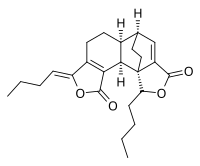 | |
| Clinical data | |
|---|---|
| Other names | (3Z')-(3a'R,6'R,3R,6R,7R)-3,8-Dihydro-6.6',7.3a'-diligustilide[1] |
| Identifiers | |
| |
| PubChem CID | |
| Chemical and physical data | |
| Formula | C24H30O4 |
| Molar mass | 382.500 g·mol−1 |
| 3D model (JSmol) | |
| |
| |
3,8-Dihydrodiligustilide is a nonsteroidal phytoprogestogen that is found in Ligusticum chuanxiong.[1][2] It is a potent agonist of the progesterone receptor (EC50 = 90 nM).[1] Another compound in the plant, riligustilide, is also a phytoprogestogen, but is almost 1,000-fold less potent and is very weak in comparison (EC50 ≈ 81 μM).[1]
See also
[edit]References
[edit]- ^ a b c d Lim LS, Shen P, Gong YH, Yong EL (2006). "Dimeric progestins from rhizomes of Ligusticum chuanxiong". Phytochemistry. 67 (7): 728–34. Bibcode:2006PChem..67..728L. doi:10.1016/j.phytochem.2006.01.024. PMID 16516938.
- ^ Ahmed HM, Yeh JY, Lin WJ, Forsberg NE, Cheng WT, Ou BR (2014). "Validation of a luciferase bioassay to detect the progestative activity in gilts whose estrus was induced by an uterotonic herb (Ligusticum chuanxiong)". Livestock Science. 163: 159–164. doi:10.1016/j.livsci.2014.02.012. ISSN 1871-1413.